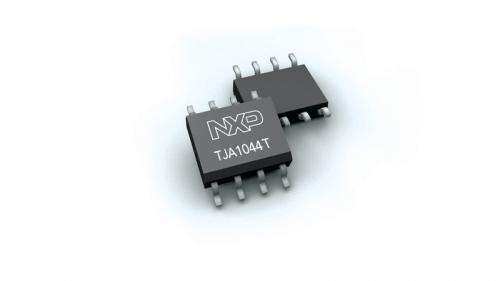NXP's Mantis CAN transceivers approved by Volkswagen for chokeless use in vehicles

Building on its industry-leading position in in-vehicle networking (IVN), NXP Semiconductors N.V. today announced that Volkswagen has approved Mantis for use in its vehicles without the need for a common-mode choke, enabling significant system cost savings in applications.
With increasing functions being introduced into the car, the performance of a modern IVN becomes increasingly critical to the vehicle's safe and reliable operation, with electro-magnetic emission and immunity against electro-magnetic interference being critical parameters to control. Automotive manufacturers define strict specifications which all transceivers must adhere to before being approved for use in the vehicle. Traditionally, a common-mode choke has been required to reach the performance limits in the application, creating an additional cost of approximately 10-15 cents (USD) per module.
NXP's new Mantis HS-CAN transceivers have demonstrated that they meet today's EMC requirements without requiring a common-mode choke. The transceivers' performance has reached a level where Volkswagen can successfully remove this additional filtering component and still meet the company's strict requirements. This not only reduces costs of applications, but also reduces module space and allows greater design flexibility.
This announcement marks the first time a German automotive manufacturer has approved a CAN transceiver for use in vehicles without a common-mode choke since the introduction of the stringent EMC requirements, including "Hardware Requirements for LIN, CAN and FlexRay Interfaces in Automotive Application – Audi, BMW, Daimler, Porsche, Volkswagen," Revision 1.3 / 2012.
Carsten Schanze, physical layer expert at Volkswagen commented: "Volkswagen adheres to the strictest EMC requirements in the industry, a critical performance criteria to ensure reliable communication of modules within the car network. We, together with the other major German car manufacturers, can only accept devices in our vehicles that fulfil these requirements. In approving NXP's Mantis transceivers, we undertook an extended testing process. Mantis transceivers are the first devices that delivered the performance for the chokeless use in our car networks and were even used to define the requirements for the location of chokeless networks in the vehicle."
"Volkswagen's approval of Mantis for use without a common-mode choke in its vehicles is a real landmark," said Toni Versluijs, vice president and general manager, in-vehicle networking business, NXP Semiconductors. "With this product, NXP has shown that it's possible to also achieve excellent EMC performance and translate this into real BOM cost savings for our customers and automotive manufacturers."
All members of the Mantis family are dual-sourced from wafer fabs in the Netherlands and Singapore to provide an agile, high-capacity and secure manufacturing base. The Mantis family of products was released in August 2013.
Features
- Fully ISO-11898-2 and ISO-11898-5 (TJA1044T and TJA1044GT only) compliant transceivers
- Dual sourced from ICN8 Nijmegen and SSMC Singapore
- Maximum voltage on CAN pins: ±42 V
- 6kV ESD handling capability on bus pins (IEC -61004-2 and HBM)
- Fully compliant to "Hardware Requirements for LIN, CAN and FlexRay Interfaces in Automotive Application – Audi, BMW, Daimler, Porsche, Volkswagen – Revision 1.3 / 2012"
- Suitable for chokeless operation at 500 kbps.
- Logic levels compatible with 3.3 V and 5 V microcontrollers
- Standby current (TJA1044T and TJA1044GT): 10 µA typical
- Fully automotive qualified to AEC-Q100
- Available in SO8 package
Provided by NXP



















